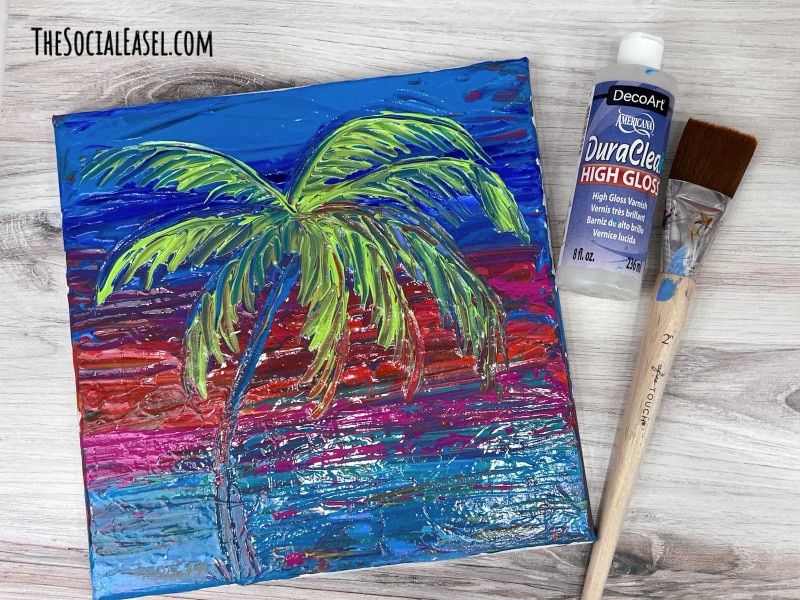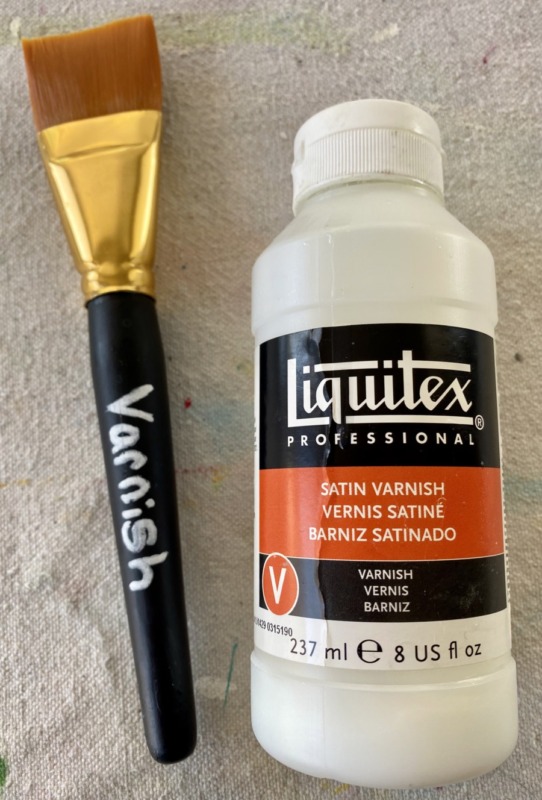To seal acrylic paint on canvas, use a clear acrylic sealer or varnish. Apply it with a brush or spray for even coverage.
Acrylic paint on canvas offers vibrant colors and versatility, making it a favorite among artists. Sealing your artwork protects it from dust, moisture, and fading, ensuring its longevity. Various sealing options exist, including spray varnishes and brush-on sealers, each providing different finishes.
Choosing the right sealant depends on your desired look and the painting’s location. A well-sealed canvas can enhance the painting’s colors while providing a protective barrier. Understanding how to properly seal your artwork will preserve your creative efforts for years to come, allowing you to enjoy your masterpiece without worry.
Contents
- Introduction To Sealing Acrylic Paint
- Types Of Sealants For Acrylic Paint
- Pre-sealing Preparations
- Application Techniques For Sealant
- Drying And Curing Process
- Common Mistakes To Avoid
- Maintenance Of Sealed Canvas
- Creative Techniques And Finishing Touches
- Faqs About Sealing Acrylic On Canvas
- Frequently Asked Questions
- Conclusion
Introduction To Sealing Acrylic Paint
Sealing acrylic paint on canvas is very important. Sealing protects your artwork from dust, dirt, and moisture. It keeps the colors vibrant and prevents fading.
Here are some benefits of a sealed canvas:
- Durability: A sealed canvas lasts longer and withstands handling.
- Color Protection: It prevents colors from fading over time.
- Easy Cleaning: Sealed surfaces are easier to wipe clean.
- UV Protection: Some sealers offer protection from harmful UV rays.
- Enhanced Finish: A seal can give your artwork a nice, polished look.

Credit: www.thesocialeaselonlinepaintstudio.com
Types Of Sealants For Acrylic Paint
Sealants help protect acrylic paint on canvas. Several types of sealants are available.
Varnishes come in three finishes: glossy, matte, and satin. Glossy varnish gives a shiny look. Matte varnish offers a non-reflective finish. Satin varnish is a mix of both.
Spray sealers are another option. They are easy to apply. Spray sealers dry quickly. They can create an even coat.
| Type | Pros | Cons |
|---|---|---|
| Varnishes | Variety of finishes | Can be tricky to apply |
| Spray Sealers | Quick application | Can overspray |
Pre-sealing Preparations
Clean the canvas surface before sealing. Use a soft cloth to remove dust. Make sure no dirt remains on the canvas. This step is very important for a good seal.
Wait until the acrylic paint is completely dry. Drying time can vary based on thickness. Touch the paint gently to check if it’s dry. Do not rush this process for best results.

Credit: stepbysteppainting.net
Application Techniques For Sealant
For the brush application method, use a clean, soft brush. Choose a sealant that suits your acrylic paint. Apply a thin layer to avoid clumps. Start from one corner and move steadily across. Use gentle strokes to cover the canvas evenly. Allow the first coat to dry completely before adding more.
For the spray application, shake the can well before use. Hold the can about 12 inches away from the canvas. Spray in a sweeping motion to cover the surface evenly. Avoid spraying too much in one spot. This method creates an even finish without brush marks. Let each layer dry before applying another.
Drying And Curing Process
Proper drying conditions are essential for sealing acrylic paint on canvas. Aim for a temperature between 65°F and 75°F. Humidity levels should be low, ideally around 40-50%. This helps the paint dry evenly and prevents smudging.
Different sealants have varied curing times. Below is a table that shows common sealants and their curing durations:
| Sealant Type | Curing Time |
|---|---|
| Acrylic Spray Sealant | 1-2 hours |
| Water-Based Varnish | 24-48 hours |
| Oil-Based Varnish | 48-72 hours |
Always follow the manufacturer’s instructions for the best results. A well-sealed canvas enhances the artwork’s longevity and vibrancy.
Common Mistakes To Avoid
Applying sealant too thickly can ruin your artwork. It may lead to uneven surfaces. Thick layers can also cause bubbles or drips. Always use a thin, even coat.
Sealing under inadequate conditions affects the final result. High humidity or temperature changes can cause issues. Ensure your workspace is dry and at a stable temperature. This helps the sealant adhere properly.
Maintenance Of Sealed Canvas
Cleaning sealed acrylic paintings is easy. Use a soft, dry cloth for dusting. Avoid using water or cleaners, as they can damage the surface. If needed, lightly dampen the cloth with water. Always test in a small area first.
For long-term care, keep paintings away from direct sunlight. This helps prevent fading and discoloration. Store paintings in a cool, dry place. Use protective coverings to avoid scratches and dust.
Regular checks for any signs of damage are essential. If you find any cracks or chips, repair them quickly. Proper care ensures your artwork stays vibrant and beautiful for years.
Creative Techniques And Finishing Touches
Texturing with sealants adds depth to your artwork. Choose a matte or glossy finish based on your style. Spray sealants work well for smooth surfaces. Brush-on sealants allow for more control. Use a sponge to create texture.
Combining sealants can give unique custom finishes. Mix a glossy sealant with a matte one for a soft sheen. Layering different types creates interesting effects. Always test the combination on a small area first. This ensures the desired result.
Faqs About Sealing Acrylic On Canvas
Sealing acrylic paint on canvas protects your artwork from fading and damage. Discover the best techniques and materials to ensure longevity. Explore common questions to enhance your understanding of the sealing process.
Choosing Between Glossy and Matte
Choosing between glossy and matte finishes is important. Glossy finishes are shiny and enhance colors. They also protect against dirt and moisture. Matte finishes are less shiny and reduce glare. They give a more natural look but may show dirt more easily.
How to Fix Sealing Mistakes
Fixing sealing mistakes is possible. Start by gently removing the sealant. Use a soft cloth to avoid damage. Next, clean the canvas with water. Let it dry completely before resealing. Choose the right finish based on your needs.

Credit: stepbysteppainting.net
Frequently Asked Questions
What Should I Use To Seal Acrylic Paint On Canvas?
To seal acrylic paint on canvas, use a clear acrylic sealer or varnish. Apply it with a brush or spray for even coverage. Choose a matte, satin, or glossy finish based on your preference. Make sure the paint is completely dry before sealing for best results.
How Do I Make Sure Acrylic Paint Stays On My Canvas?
To ensure acrylic paint stays on your canvas, start with a primed surface. Use high-quality acrylic paints for better adhesion. Apply thin layers to avoid cracking. Allow each layer to dry completely before adding more. Finally, seal your artwork with a clear acrylic varnish for added protection.
How Do You Finish An Acrylic Painting On Canvas?
To finish an acrylic painting on canvas, allow it to dry completely. Apply a varnish for protection and a glossy finish. Use a clean brush for even application. Consider framing the artwork for display. Finally, sign your piece to add a personal touch.
Can I Use Hairspray To Seal Acrylic Paint?
Using hairspray to seal acrylic paint is not recommended. Hairspray may cause yellowing and damage over time. Instead, opt for a dedicated acrylic sealer for better protection and longevity. This ensures your artwork remains vibrant and intact. Choose products specifically designed for acrylics for the best results.
Conclusion
Sealing acrylic paint on canvas is essential for preserving your artwork. It protects against UV rays, moisture, and dust. Choose the right sealant for your specific needs. Regular maintenance will keep your piece looking fresh. Invest time in sealing to enhance the longevity and beauty of your creations.
Happy painting!
